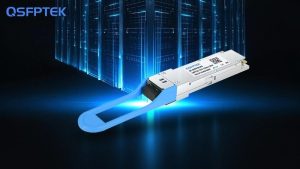
In the fast-paced world of financial trading, speed and security are paramount. The 100G IR4 (Intermediate Reach) optical transceiver module has emerged as a critical component in enhancing the performance of financial sector networks, particularly in high-frequency trading (HFT) and secure data transmission. This article explores the application of 100G IR4 modules in financial institutions, focusing on their role in supporting HFT and ensuring secure data transmission.
Understanding 100G IR4 Modules
The 100G IR4 module is an optical transceiver designed for 100 Gigabit Ethernet (100GbE) applications, offering intermediate reach capabilities typically up to 2 kilometers over single-mode fiber. It utilizes four channels (lambdas) at 25 Gbps each, multiplexed to achieve a total data rate of 100 Gbps. This configuration makes it suitable for connecting data centers and network infrastructures within metropolitan areas.
Enhancing High-Frequency Trading (HFT)
High-frequency trading relies on executing a large number of trades in fractions of a second, necessitating ultra-low latency and high-speed data transmission. The deployment of 100G IR4 modules addresses these requirements in several ways:
Ciena Website | Ciena
Reduced Latency: By providing high-speed data transmission over intermediate distances, 100G IR4 modules minimize the time it takes for data to travel between trading platforms and exchanges. This reduction in latency is crucial for HFT firms aiming to capitalize on fleeting market opportunities.
Increased Bandwidth: The 100 Gbps capacity of IR4 modules supports the massive data volumes generated by HFT algorithms, ensuring that network infrastructures can handle peak trading periods without congestion.
Network Simplification: Utilizing 100G IR4 modules allows financial institutions to consolidate multiple lower-speed connections into a single high-speed link, simplifying network architectures and reducing potential points of failure.
NYSE Euronext’s 100G Deployment
A notable example of 100G technology implementation in the financial sector is NYSE Euronext’s deployment of a 100 Gbps network to support its trading operations. In 2009, NYSE Euronext collaborated with Ciena to implement a 100G network, aiming to provide ultra-low latency and high-capacity data transmission for its trading platforms. This deployment was part of NYSE Euronext’s strategy to handle increasing trading volumes and the demand for faster transaction speeds.
Ensuring Secure Data Transmission
Beyond speed, security is a critical concern for financial institutions. The implementation of QSFP28 IR4 modules contributes to secure data transmission in the following ways:
Dedicated Fiber Links: Deploying 100G IR4 modules over dedicated single-mode fiber links reduces the risk of data interception compared to shared network infrastructures, enhancing the confidentiality of sensitive financial transactions.
Advanced Encryption: Many 100G IR4 modules support built-in encryption protocols, ensuring that data transmitted over the network is protected from unauthorized access and tampering.
Network Isolation: High-capacity links enabled by 100G IR4 modules allow for the creation of isolated network segments, limiting exposure to potential security threats and containing any breaches that may occur.
Economic and Operational Benefits
The adoption of 100G IR4 modules also offers economic and operational advantages:
Cost Efficiency: By consolidating multiple lower-speed connections into a single 100G link, financial institutions can reduce infrastructure complexity and associated maintenance costs.
Scalability: The high bandwidth provided by 100G IR4 modules ensures that network infrastructures can accommodate future growth in trading volumes and data transmission needs without significant upgrades.
Energy Efficiency: Modern 100G IR4 modules are designed to be energy-efficient, reducing the power consumption of network equipment and contributing to lower operational expenses.
Conclusion
The integration of 100G IR4 modules into financial sector networks plays a pivotal role in enhancing the performance and security of trading operations. By providing ultra-low latency, high-bandwidth, and secure data transmission, these modules support the demanding requirements of high-frequency trading and other financial applications. Financial institutions that adopt 100G IR4 technology position themselves to effectively compete in the fast-evolving trading landscape, ensuring both operational excellence and robust security measures.